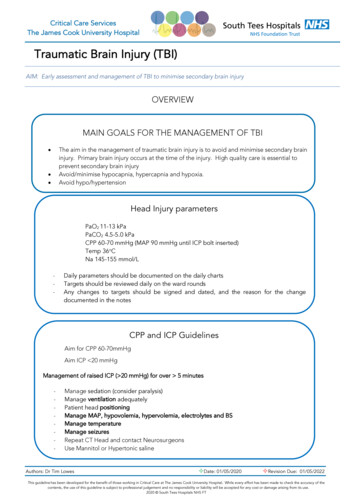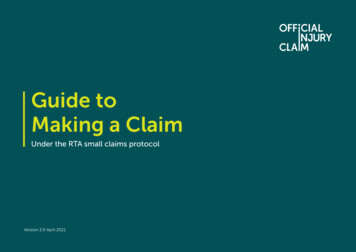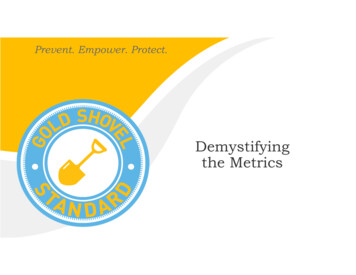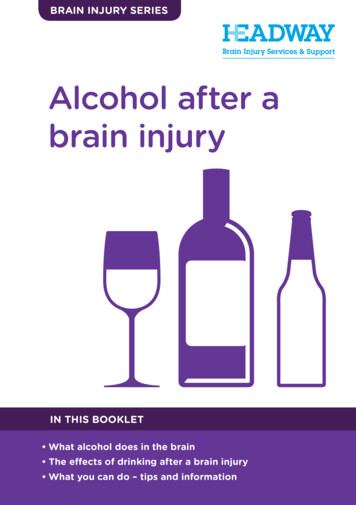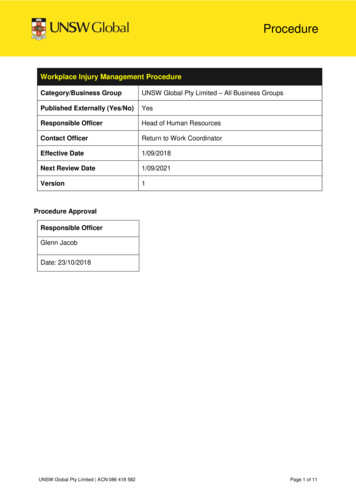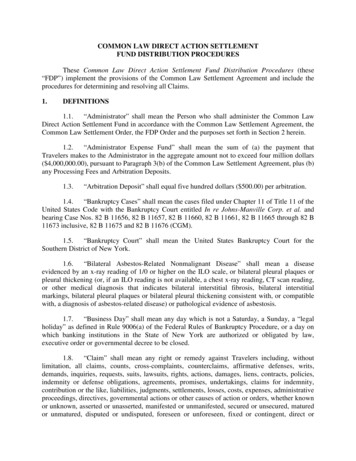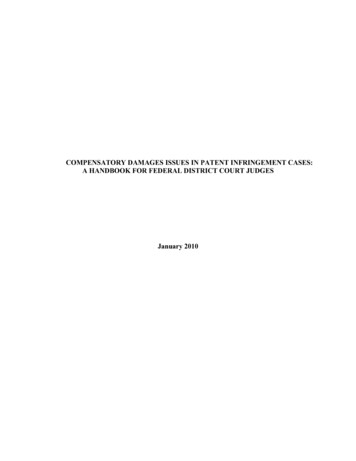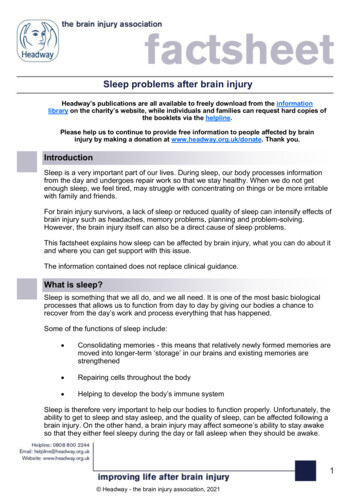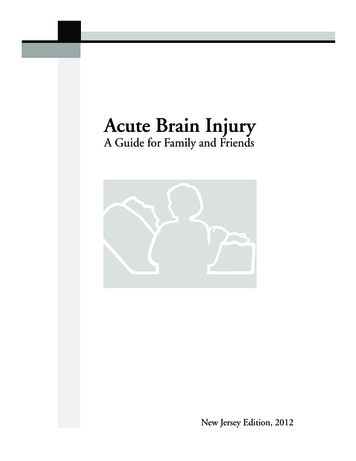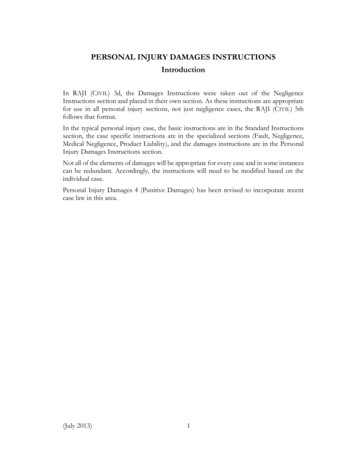
Transcription
PERSONAL INJURY DAMAGES INSTRUCTIONSIntroductionIn RAJI (CIVIL) 3d, the Damages Instructions were taken out of the NegligenceInstructions section and placed in their own section. As these instructions are appropriatefor use in all personal injury sections, not just negligence cases, the RAJI (CIVIL) 5thfollows that format.In the typical personal injury case, the basic instructions are in the Standard Instructionssection, the case specific instructions are in the specialized sections (Fault, Negligence,Medical Negligence, Product Liability), and the damages instructions are in the PersonalInjury Damages Instructions section.Not all of the elements of damages will be appropriate for every case and in some instancescan be redundant. Accordingly, the instructions will need to be modified based on theindividual case.Personal Injury Damages 4 (Punitive Damages) has been revised to incorporate recentcase law in this area.(July 2013)1
REVISED ARIZONA JURY INSTRUCTIONS (CIVIL), 6THPERSONAL INJURY DAMAGES 10Measure of DamagesIf you find [any] [name of defendant] liable to [name of plaintiff], you must then decide the fullamount of money that will reasonably and fairly compensate [name of plaintiff] for each ofthe following elements of damages proved by the evidence to have resulted from the faultof [any] [name of defendant] [party] [person]:11. The nature, extent, and duration of the injury.2. The pain, discomfort, suffering, disability, disfigurement, and anxiety alreadyexperienced, and reasonably probable to be experienced in the future as a result of theinjury.3. Reasonable expenses of necessary medical care, treatment, and services rendered, andreasonably probable to be incurred in the future.2ContinuedUSE NOTE: 1 Use the appropriate bracketed language, as follows:1. “defendant” – One defendant, no claim of plaintiff’s fault.2. “any defendant” – More than one defendant, no claim of plaintiff’s fault3. “any party” – One or more defendants, claim of plaintiff’s fault.4. “any person” – One or more defendants, claim of non-party fault (with or without a claim ofplaintiff’s fault).5. Alternatives: Any appropriate combination of the above; or, identify by name all those whomight be at fault; or, simply say: “. . . resulted from any fault in the case.”Modifications: Depending on the evidence in the case, some of the elements in Paragraphs 2, 3,4, 5, and 6 may be inapplicable or cumulative, and some unlisted elements may be applicable andnot cumulative. Customize the instruction to fit the case.Property Damage Claim: If there is a property claim, add, as the last element of the instruction:“(7) The difference in the value of the damaged property immediately before and immediately afterthe damage.”2 Lopezv. Safeway Stores, Inc., 212 Ariz. 198, 129 P.3d 487 (Ct. App. 2006); Saide v. Stanton, 135 Ariz.76, 77, 659 P.2d 35, 36 (1983).3 International Harvester Co. v. Chiarello, 27 Ariz. App. 411 (Ct. App. 1976). See also Kaufman v. Langhofer,239 Ariz. 249, 222 P.3d 272 (Ct. App. 2009) (“A cause of action for loss of consortium is alsolimited to spouses, parents, and children.”) (citing Barnes v. Outlaw, 192 Ariz. 283, 286, 964 P.2d484, 487 (1998) (spouses); Villareal v. State Dep't of Transp., 160 Ariz. 474, 477, 774 P.2d 213, 216(1989) (parents); Frank v. Superior Court, 150 Ariz. 228, 234, 722 P.2d 955, 961 (1986) (children)).(July 2013)2
PERSONAL INJURY DAMAGES 10Measure of DamagesContinued4. Lost earnings to date, and any decrease in earning power or capacity in the future.5. Loss of love, care, affection, companionship, and other pleasures of the [marital][parent-child] relationship.36. Loss of enjoyment of life, that is, the participation in life’s activities to the quality andextent normally enjoyed before the injury.4USE NOTE: 1 Use the appropriate bracketed language, as follows:6. “defendant” – One defendant, no claim of plaintiff’s fault.7. “any defendant” – More than one defendant, no claim of plaintiff’s fault8. “any party” – One or more defendants, claim of plaintiff’s fault.9. “any person” – One or more defendants, claim of non-party fault (with or without a claim ofplaintiff’s fault).10. Alternatives: Any appropriate combination of the above; or, identify by name all those whomight be at fault; or, simply say: “. . . resulted from any fault in the case.”Modifications: Depending on the evidence in the case, some of the elements in Paragraphs 2, 3,4, 5, and 6 may be inapplicable or cumulative, and some unlisted elements may be applicable andnot cumulative. Customize the instruction to fit the case.Property Damage Claim: If there is a property claim, add, as the last element of the instruction:“(7) The difference in the value of the damaged property immediately before and immediately afterthe damage.”2 Lopezv. Safeway Stores, Inc., 212 Ariz. 198, 129 P.3d 487 (Ct. App. 2006); Saide v. Stanton, 135 Ariz.76, 77, 659 P.2d 35, 36 (1983).3 International Harvester Co. v. Chiarello, 27 Ariz. App. 411 (Ct. App. 1976). See also Kaufman v. Langhofer,239 Ariz. 249, 222 P.3d 272 (Ct. App. 2009) (“A cause of action for loss of consortium is alsolimited to spouses, parents, and children.”) (citing Barnes v. Outlaw, 192 Ariz. 283, 286, 964 P.2d484, 487 (1998) (spouses); Villareal v. State Dep't of Transp., 160 Ariz. 474, 477, 774 P.2d 213, 216(1989) (parents); Frank v. Superior Court, 150 Ariz. 228, 234, 722 P.2d 955, 961 (1986) (children)).Continued(July 2013)3
REVISED ARIZONA JURY INSTRUCTIONS (CIVIL), 6TH14 SeeOgden v. J.M. Steel Erecting, Inc., 201 Ariz. 32, 38-39, 31 P.3d 806, 812-13 (Ct. App. 2001)(holding that “hedonic damages can be a component of a general damages claim, distinguishablefrom, and not duplicative of, damages for pain and suffering.”); but see Quintero v. Rogers, 221 Ariz.536, 539, 212 P.3d 874, 877(Ct. App. 2009) (finding that “loss of enjoyment of life” damages arewithin the category of “pain and suffering” damages excluded by Arizona’s survival statute,A.R.S. § 14-3110.)(July 2013)4
PERSONAL INJURY DAMAGES 2Pre-Existing Condition,Unusually Susceptible Plaintiff[Name of plaintiff] is not entitled to compensation for any physical or emotional conditionthat pre-existed the fault of [name of defendant]. However, if [name of plaintiff] had any preexisting physical or emotional condition that was aggravated or made worse by [name ofdefendant]’s fault, you must decide the full amount of money that will reasonably and fairlycompensate [name of plaintiff] for that aggravation or worsening.You must decide the full amount of money that will reasonably and fairly compensate[name of plaintiff] for all damages caused by the fault of [name of defendant], even if [name ofplaintiff] was more susceptible to injury than a normally healthy person would have been,and even if a normally healthy person would not have suffered similar injury.0SOURCE: JUDICIAL COUNCIL OF CALIFORNIA CIVIL JURY INSTRUCTIONS (2003-04), CACI No.3928.USE NOTE: 1. Identification of Possible Parties at Fault: The instruction is drafted for a onedefendant, no comparative fault case. In other cases, replace “defendant” here with the samelanguage used in RAJI (CIVIL) 5th Personal Injury Damages 1 from the “[any] [defendant] [party][person]” options.2. The Two Principles Covered by this Instruction: Use the first paragraph when there is anissue of aggravation of pre-existing condition. (“Worsening” has been added as a clarification of“aggravation”; some may find the instruction just as clear with one or the other of those conceptsremoved.) Use the second paragraph when there is an issue of injury to an unusually susceptibleperson. Use both paragraphs if both issues are in the case.3. “Fault” or “Negligence”: If desired, “negligence” can be substituted for “fault” in thisinstruction; the instruction will be correct either way.(July 2013)5
REVISED ARIZONA JURY INSTRUCTIONS (CIVIL), 6THPERSONAL INJURY DAMAGES 3Damages for Wrongful Death of Spouse,Parent, or ChildIf you find [name of defendant] liable to [name of plaintiff], you must then decide the full amountof money that will reasonably and fairly compensate [name of each survivor] [separately] foreach of the following elements of damages proved by the evidence to have resulted from thedeath of [name of decedent].1. The loss of love, affection, companionship, care, protection, and guidance since thedeath and in the future.2. The pain, grief, sorrow, anguish, stress, shock, and mental suffering already experienced,and reasonably probable to be experienced in the future.3. The income and services that have already been lost as a result of the death, and that arereasonably probable to be lost in the future.4. The reasonable expenses of funeral and burial.5. The reasonable expenses of necessary medical care and services for the injury thatresulted in the death.0SOURCE: A.R.S. § 12-613; City of Tucson v. Wondergem, 105 Ariz. 429, 466P.2d 383 (1970); Jeffery v.United States, 381 F. Supp. 505, 510 (Ariz. 1974); Salinas v. Kahn, 2 Ariz. App. 181, 193-95, 407 P.2d120, 132-34 (1965).See also White v. Greater Ariz. Bicycling Ass’n, 216 Ariz. 133, 136, 163 P.3d 1083, 1086 (Ct. App. 2007);Mullen v. Posada Del Sol Health Care Ctr., 169 Ariz. 399, 400, 819 P.2d 985, 986 (Ct. App. 1991).USE NOTE: Depending on the evidence in the case, some of the elements in paragraphs 1 and 2may be inapplicable or cumulative, and the elements listed in paragraphs 3, 4, and 5 may beinapplicable. Customize the instruction to fit the case.(July 2013)6
PERSONAL INJURY DAMAGES 4 Punitive DamagesIf you find [name of defendant] liable to [name of plaintiff], you may consider assessing additionaldamages to punish [name of defendant] or to deter [name of defendant] and others from similarmisconduct in the future. Such damages are called “punitive” damages.To recover punitive damages, [name of plaintiff] has the burden of proving by clear andconvincing evidence, either direct or circumstantial, that [name of defendant] engaged in themisconduct with one or more of the following states of mind:1. [Name of defendant] intended to cause injury; or2. [Name of defendant] was motivated by spite or ill will; or3. a. [Name of defendant] acted to serve his own interests, having reason to knowand consciously disregarding a substantial risk that his conduct might significantlyinjure the rights of others; orb. [Name of defendant] consciously pursued a course of conduct knowing that itcreated a substantial risk of significant harm to others.To prove this required state of mind by clear and convincing evidence, [name of plaintiff]must persuade you that the punitive damages claim is highly probable. This burden of proofis more demanding than the burden of proof of “more probably true than not true,” whichapplies to all other claims in this case, but it is less demanding than the burden of proofof “beyond a reasonable doubt,” which is used in criminal cases.The law provides no fixed standard for the amount of punitive damages you may assess, ifany, but leaves the amount to your discretion. [However, if you assess punitive damages,you may consider the character of [name of defendant]’s conduct or motive, the nature andextent of the harm to plaintiff that [name of defendant] caused, and the nature and extent ofdefendant’s financial wealth.]ContinuedSOURCES:1. Elements of Punitive Damages: Bradshaw v. State Farm Mut. Auto. Ins., 157 Ariz. 411,422, 758P.2d 1313, 1324 (1988); Volz v. Coleman Co., Inc., 155 Ariz. 567, 570, 748 P.2d 1191, 1194 (1987);Gurule v. Ill. Mut. Life & Cas. Co., 152 Ariz. 600, 601-02, 734 P.2d 85, 86-87 (1987); Hawkins v.Allstate Ins. Co., 152 Ariz. 490, 497, 733 P.2d 1073, 1080 (1987); Linthicum v. Nationwide Life Ins.Co., 150 Ariz. 326, 330-31, 723 P.2d 675, 679-80 (1986); Rawlings v. Apodaca, 151 Ariz. 149, 16163, 726 P.2d 565, 577-79 (1986).2. Definition of Clear and Convincing: Thompson v. Better-Bilt Aluminum Prod. Co., 171 Ariz. 550,557, 823 P.2d 203, 210 (1992); State v. King, 158 Ariz. 419, 422, 763 P.2d 239, 242 (1988); Statev. Renforth, 155 Ariz. 385, 387, 746 P.2d 1315, 1317 (App. 1987).Continued(May 2018)7
REVISED ARIZONA JURY INSTRUCTIONS (CIVIL), 6THPERSONAL INJURY DAMAGES 4Punitive DamagesContinued USE NOTES:1. State of Mind Categories 3(a) and 3(b): Use the language most appropriate for the case. Thestatement i n 3 ( a ) is taken directly from Bradshaw; the statement in 3(b) is taken directly fromGurule. Although the statements cover the same principle, there are differences between the two.In some cases, therefore, one statement might be preferable to the other. Select one of thestatements, but probably not both, as appropriate for the case. Or replace both statements withother satisfactory language expressing the same principle. See Comment 1, infra.2. Burden of Proof Paragraph: The burden of proof contained in this instruction is for use whenthe only claim in the case requiring proof by clear and convincing evidence is for punitivedamages. If the clear and convincing standard applies to both punitive damages and other kindsof claims in the case, delete the burden of proof paragraph here and use RAJI (CIVIL) 5thStandard 3. In either situation, also use RAJI (CIVIL) 5th Standard 2.3. Brackets: The brackets in this paragraph indicate that some of the factors listed could be deletedor others added, depending on the evidence in a particular case.COMMENTS:1. Evil Mind: Beginning with the 1986 cases of Linthicum and Rawlings, the Arizona SupremeCourt has redefined the conduct, state of mind, and level of proof required for assessmentof punitive damages. In Linthicum, the court stated that a claim for punitive damages requiresproof that the defendant’s conduct was guided by an “evil mind”. Although the case law sinceLinthicum has used the phrase “evil mind” as short hand to describe the state of mind toestablish a claim for punitive damages, the Committee has concluded that the phrase “evilmind” should not be included in the jury instruction. The Committee reasoned that the phrasewas a legal term of art that could be confusing to jurors because they might apply or beinfluenced by their own religious or social perspective. Accordingly, the instruction identifiesthe alternative ways of establishing “evil mind,” but does not include the words “evil mind.”RAJI (CIVIL) 5th Personal Injury Damages 4 provides alternative ways to show the “evil mind”element of a punitive damages claim. The specific language for these alternatives is directly fromBradshaw and Gurule. The Committee does not suggest that the alternatives set forth in theinstruction are exclusive of all others, or that they have been stated here in the only correct way.The Arizona Supreme Court opinions contain many statements and expressions discussing anddefining “evil mind.” The trial court may find other “evil mind” statements or formulations moreappropriate for a particular case than any of those provided in Personal Injury Damages 4; inthat event, the instruction may serve as a template.2. Whether Aggravated or Outrageous Conduct Is a Required Element of PunitiveDamages: In Rawlings, the Arizona Supreme Court held that in order to recover punitivedamages, there must be evidence that the “defendant’s wrongful conduct was guided by evilContinued(July 2013)8
PERSONAL INJURY DAMAGES 4Punitive DamagesContinuedmotives.” Rawlings v. Apodaca, 151 Ariz. 149, 162, 726 P.2d 565, 578 (1986). The Courtcontinued, “When defendant's motives are shown to be so improper, or its conduct sooppressive, outrageous or intolerable that such an “evil mind” may be inferred, punitivedamages may be awarded.” Id. at 162-63, 726 P.2d at 578-79. The day after the Supreme Courtissued Rawlings, it stated in Linthicum, “While the necessary ‘evil mind’ may be inferred, it is stillthis ‘evil mind’ in addition to outwardly aggravated, outrageous, malicious, or fraudulent conductwhich is required for punitive damages. We hold that before a jury may award punitivedamages there must be evidence of an ‘evil mind’ and aggravated and outrageous conduct.”Linthicum v. Nationwide Life Ins. Co., 150 Ariz. 326, 331, 723 P.2d 675, 680 (1986) (emphasisadded). The following year, the Supreme Court stated in Gurule, “Even if the defendant’sconduct was not outrageous, a jury may infer evil mind if defendant deliberately continued hisactions despite the inevitable or highly probable harm that would follow.” Gurule v. Ill. Mut.Life & Cas. Co., 152 Ariz. 600, 602, 734 P.2d 85, 87 (1987) (emphasis added). Because neitherLinthicum nor the subsequent cases that quote its language above clearly establish a separateelement of “outwardly aggravated” or “outrageous” conduct that is not subsumed in the “evilmind” requirement, the Committee has concluded that the existing instruction’s focus on “evilmind” should be maintained.3. DUI or Other Voluntary Intoxication Cases: If there is adequate evidence that plaintiff’s injuryresulted from defendant’s driving while under the influence of intoxicating liquors, a punitivedamages instruction is probably warranted. However, “intoxication alone, in the absence of othercompelling circumstances, may not warrant punitive damages.” Olson v. Walker, 162 Ariz. 174,179, 781 P.2d 1015, 1020 (App. 1989).4. Causation: The plaintiff also must prove that the same conduct that provides the basis forpunitive damages was a cause of, or contributed to, injury to the plaintiff. Saucedo v. SalvationArmy, 200 Ariz. 179, 182, 24 P.3d 1274, 1277 (App. 2001) (act of leaving scene of hit and runcould not establish “evil mind” for punitive damages because pedestrian died on impact anddefendant’s failure to remain did not contribute to harm).(May 2018)9
REVISED ARIZONA JURY INSTRUCTIONS (CIVIL), 6THPERSONAL INJURY DAMAGES 42Punitive DamagesContinued5. Constitutional Issues: Due process limits on punitive damages are imposed by courts ratherthan juries. See Cooper Indus., Inc. v. Leatherman Tool Grp., Inc., 532 U.S. 424, 437 (2001). Thus,the constitutional issues associated with the imposition of punitive damages are notappropriate for consideration by juries or inclusion of jury instructions. To assist attorneysin understanding the three guideposts courts consider when evaluating after the trial whetheran award of punitive damages violates the Due Process Clause, the Committee has providedthe following citations: State Farm Mut. Auto. Ins. Co. v. Campbell, 538 U.S. 408 (2003), BMW ofN. Am., Inc. v. Gore, 517 U.S. 559 (1996); TXO Prod. Corp. v. Alliance Res. Corp., 509 U.S. 443 (1993);Pac. Mut. Life. Ins. Co. v. Haslip, 499 U.S. 1 (1991); Philip Morris USA v. Williams, 549 U.S. 346,352 (2007) (punitive damages cannot be awarded for causing injury to any nonparty) ; Arellano v.Primerica Life Ins. Co., Co., 235 Ariz. 371, 378-80, 332 P.3d 597, 604-06 (App. 2014) (reducingpunitive damages award with a 13:1 ratio of punitive to compensatory damages to 4:1 ratio underGore and Campbell); Nardelli v. Metro. Grp. Prop. & Cas. Ins. Co., 230 Ariz. 592, 609-12, 277 P.3d789, 806-09 (App. 2012) (where jury returned 355:1 punitive damages award, further reducingtrial court’s 4:1 award to 1:1); Hudgins v. Sw. Airlines, Co., 221 Ariz. 472, 489-92, 212 P.3d 810,827-30 (App. 2009) (reducing jury’s 8:1 punitive damages award to 1:1); Sec. Title Agency, Inc. v.Pope, 219 Ariz. 480, 500-04, 200 P.3d 977, 997-1001 (App. 2008) (reducing jury’s 6:1 punitivedamages award to 1:1). Although an appellate court has discretion to consider a constitutionalissue raised for the first time on appeal, due process concerns regarding the size of the punitivedamages award should be raised with the trial court in order to preserve the issue for appeal. SeeMarquette Venture Partners II, L.P. v. Leonesio, 227 Ariz. 179, 185, ¶¶ 24-25, 254 P.3d 418, 424 (App.2011).(July 2013)10
PERSONAL INJURY DAMAGES 5Mortality Tables and Life ExpectancyA person agedyears has a life expectancy ofyears. This is merely an estimateof the probable average remaining length of life of all persons of this age.This estimate may be considered by you in determining the amount of damages for anypermanent injury proved by the evidence to have resulted from the fault of [any] [name ofdefendant] [party] [person].0SOURCE: National Vital Statistics Reports, Volume 61, No. 3, September 24, 2012.(May 2018)11
PERSONAL INJURY DAMAGES INSTRUCTIONS . Introduction. In . RAJI (CIVIL) 3d, the Damages Instructions were taken out of the Negligence Instructions section and placed in their own section. As these instructions are appropriate for use in all personal injury sections, not just negligence cases, the RAJI IVIL) 5th (C follows that format.
